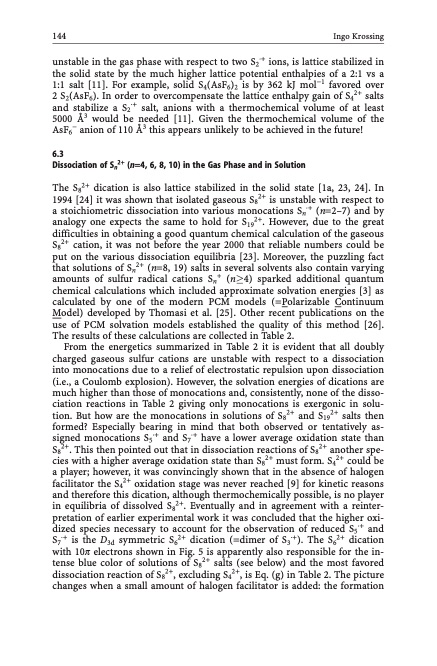
PDF Publication Title:
Text from PDF Page: 154
144 Ingo Krossing unstable in the gas phase with respect to two S2·+ ions, is lattice stabilized in the solid state by the much higher lattice potential enthalpies of a 2:1 vs a 1:1 salt [11]. For example, solid S4(AsF6)2 is by 362 kJ mol1 favored over 2 S2(AsF6). In order to overcompensate the lattice enthalpy gain of S42+ salts and stabilize a S2·+ salt, anions with a thermochemical volume of at least 5000 3 would be needed [11]. Given the thermochemical volume of the AsF6 anion of 110 3 this appears unlikely to be achieved in the future! 6.3 Dissociation of Sn2+ (n=4, 6, 8, 10) in the Gas Phase and in Solution The S82+ dication is also lattice stabilized in the solid state [1a, 23, 24]. In 1994 [24] it was shown that isolated gaseous S82+ is unstable with respect to a stoichiometric dissociation into various monocations Sn·+ (n=2–7) and by analogy one expects the same to hold for S192+. However, due to the great difficulties in obtaining a good quantum chemical calculation of the gaseous S82+ cation, it was not before the year 2000 that reliable numbers could be put on the various dissociation equilibria [23]. Moreover, the puzzling fact that solutions of Sn2+ (n=8, 19) salts in several solvents also contain varying amounts of sulfur radical cations Sn+ (n4) sparked additional quantum chemical calculations which included approximate solvation energies [3] as calculated by one of the modern PCM models (=Polarizable Continuum Model) developed by Thomasi et al. [25]. Other recent publications on the use of PCM solvation models established the quality of this method [26]. The results of these calculations are collected in Table 2. From the energetics summarized in Table 2 it is evident that all doubly charged gaseous sulfur cations are unstable with respect to a dissociation into monocations due to a relief of electrostatic repulsion upon dissociation (i.e., a Coulomb explosion). However, the solvation energies of dications are much higher than those of monocations and, consistently, none of the disso- ciation reactions in Table 2 giving only monocations is exergonic in solu- tion. But how are the monocations in solutions of S82+ and S192+ salts then formed? Especially bearing in mind that both observed or tentatively as- signed monocations S5·+ and S7·+ have a lower average oxidation state than S82+. This then pointed out that in dissociation reactions of S82+ another spe- cies with a higher average oxidation state than S82+ must form. S42+ could be a player; however, it was convincingly shown that in the absence of halogen facilitator the S42+ oxidation stage was never reached [9] for kinetic reasons and therefore this dication, although thermochemically possible, is no player in equilibria of dissolved S82+. Eventually and in agreement with a reinter- pretation of earlier experimental work it was concluded that the higher oxi- dized species necessary to account for the observation of reduced S5·+ and S7·+ is the D3d symmetric S62+ dication (=dimer of S3·+). The S62+ dication with 10p electrons shown in Fig. 5 is apparently also responsible for the in- tense blue color of solutions of S82+ salts (see below) and the most favored dissociation reaction of S82+, excluding S42+, is Eq. (g) in Table 2. The picture changes when a small amount of halogen facilitator is added: the formationPDF Image | Topics in Current Chemistry

PDF Search Title:
Topics in Current ChemistryOriginal File Name Searched:
Elemental-Sulfur-und-Sulfur-Rich-Compounds-I.pdfDIY PDF Search: Google It | Yahoo | Bing
Sulfur Deposition on Carbon Nanofibers using Supercritical CO2 Sulfur Deposition on Carbon Nanofibers using Supercritical CO2. Gamma sulfur also known as mother of pearl sulfur and nacreous sulfur... More Info
CO2 Organic Rankine Cycle Experimenter Platform The supercritical CO2 phase change system is both a heat pump and organic rankine cycle which can be used for those purposes and as a supercritical extractor for advanced subcritical and supercritical extraction technology. Uses include producing nanoparticles, precious metal CO2 extraction, lithium battery recycling, and other applications... More Info
| CONTACT TEL: 608-238-6001 Email: greg@infinityturbine.com | RSS | AMP |